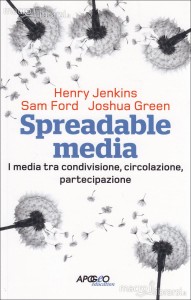 I have a friend who believes every article, post, tweet he needs to read will come to him every day by new media.
I have a friend who believes every article, post, tweet he needs to read will come to him every day by new media.
And he’s right. We act as editors for one another. We see something, we say something…on Twitter, Facebook, Tumbler, LinkedIn and elsewhere.
But he’s wrong. I bet he misses things. I know I do. Plus, some things can’t get into new media. They just don’t.
Take TV. We watch a lot of TV. And my Netflix research winter tells me that we watch this TV with new attention to detail and a deep inclination to talk about it. We find favorite scenes, brilliant bits of acting, very special effects, but all of this remains locked in the box. It just isn’t “spreadable,” to use the language of Henry Jenkins, Sam Ford and Josh Green. (That’s their book cover above. Highly recommended. Forgive the Italian subtitle. Buy the book here.)
This is a classic case of the old media failing to seize the opportunities opened up by new media. Imagine how many of the shows that failed this fall season might have made it if their early fans could have got the word out.
What we need is some tech overlay that makes clipping and sharing easy and possible. Build it into the remote control. Put on an IN button and an OUT button and a CLIP button and a SHARE button.
I am sure there are legal issues here, but I am equally certain Lawrence Lessig or Jonathan Zittrain could sort them out over lunch time. The copy right holders are, after all, deeply incented to permit the passage of small clips. Permit? What Jenkins, Ford and Green say about spreadable media, applies especially to every new season of television. If it doesn’t spread, it’s dead.
In the meantime, we can resort to efforts of our own. Here’s a clip from one of my favorite shows, Being Human. This is Sally, a ghost, explaining how she intends to protect the house from sale. (Remember, she’s a ghost and therefore invisible to mortals.)
I shot this with my iPhone. Something less that stellar quality. But good enough for the internet, as they say. Some people are put off by Being Human because it’s on SyFy (they don’t like science fiction) or because the show has such a weird premise (the creatures “being human” are a ghost, a vampire, and a ghost). But I think this scene takes us beyond odd premises into the heart of the show. Several “barriers to entry” fall. SyFy wants this clip to click.
God knows, we have quite a lot of content circulating on line. The numbers are simply breathtaking. But the fact of the matter is that TV preoccupies us. And it’s getting better. As it stands, this part of our culture is excluded from the conversation. This should change.

